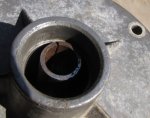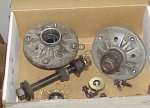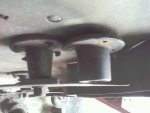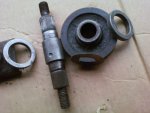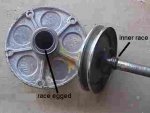SeniorCitizen
Lawn Addict
- Joined
- Aug 28, 2010
- Threads
- 123
- Messages
- 2,108
If we look closely at the picture we can we see that the spacer is proud of the outer race seat. The reason we know the spacer is longer than the distance between the lower and upper bearing bosses is because the spacer is resting on the lower bearing inner race that I pressed in until the outer race was stopped by the bearing boss ( seat ). The amount it is proud really doesn't matter unless it protrudes less than about 0.001" but you'll never see that . The one pictured is more near the norm and in fact it protrudes above the bearing boss 0.060" . Could it be shorter by 0.060" ? It could be and that would be just as bad, but you'll never see one shorter.
So what's the problem Senior Citizen ? It must be correct because it's factory.
This is the problem.
When the factory engineer BUBBA made this one he designed it for both bearings to be pressed in ( not true in all instances ). Now the assembly man/woman, we'll call her BUBBA too, presses these bearings in, the first one goes in by ( hopefully ) pressing on the outer race with that BIG OLE Press and boy that puppy is fast. That thing sure socked it toit. Next step is to place the spacer in there followed by the second bearing and press operation.
Now here is where the problem begins. When the inner bearing race just reaches the spacer did BUBBA stop pressing. No he didn't because nothing feels solid at this point and BUBBA engineer said until it feels solid. He continues to press until the outer race reaches its seat and all feels good and firm. By continuing to press he has put an u-due lateral pre-load on both bearings. In the case of the pictured assembly that pre-load could be as much as 0.060" on one bearing or some on it and the remainder on the lower bearing, depending whether the first bearing installed outer race moved. The end result is a shortened bearing life. Ball bearings excel with radial thrust but preform poorly with lateral thrust.
This is all the same whether Bubba did it at the factory or you/we do it at our shop with a big hammer and big socket to drive the bearing in.
So what's the solution.
Some manufacturers have been building so one of the bearings is a push fit. When the press fit bearing is installed first until it seats, the spacer is installed then the second push fit bearing with our fingers / thumbs is installed, that bearing is free floating and that solves the problem of lateral thrust.
When I find this problem, rather than attempting to bore the housing larger by a thousandths or two, modifying the outer race diameter until the push fit requirement is satisfied takes only a few seconds.
So what's the problem Senior Citizen ? It must be correct because it's factory.
This is the problem.
When the factory engineer BUBBA made this one he designed it for both bearings to be pressed in ( not true in all instances ). Now the assembly man/woman, we'll call her BUBBA too, presses these bearings in, the first one goes in by ( hopefully ) pressing on the outer race with that BIG OLE Press and boy that puppy is fast. That thing sure socked it toit. Next step is to place the spacer in there followed by the second bearing and press operation.
Now here is where the problem begins. When the inner bearing race just reaches the spacer did BUBBA stop pressing. No he didn't because nothing feels solid at this point and BUBBA engineer said until it feels solid. He continues to press until the outer race reaches its seat and all feels good and firm. By continuing to press he has put an u-due lateral pre-load on both bearings. In the case of the pictured assembly that pre-load could be as much as 0.060" on one bearing or some on it and the remainder on the lower bearing, depending whether the first bearing installed outer race moved. The end result is a shortened bearing life. Ball bearings excel with radial thrust but preform poorly with lateral thrust.
This is all the same whether Bubba did it at the factory or you/we do it at our shop with a big hammer and big socket to drive the bearing in.
So what's the solution.
Some manufacturers have been building so one of the bearings is a push fit. When the press fit bearing is installed first until it seats, the spacer is installed then the second push fit bearing with our fingers / thumbs is installed, that bearing is free floating and that solves the problem of lateral thrust.
When I find this problem, rather than attempting to bore the housing larger by a thousandths or two, modifying the outer race diameter until the push fit requirement is satisfied takes only a few seconds.

